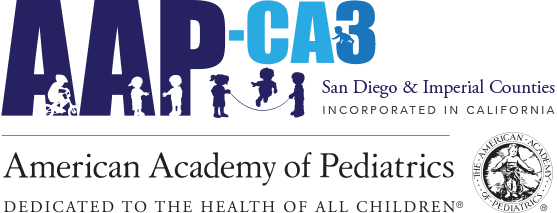


Immunizations for San Diego Kids
August 31, 2016


Teen Safe Driving – Resources for Pediatricians
September 7, 2016The American Academy of Pediatrics and The Allstate Foundation are joining forces in 2013-14 to reduce teen driving deaths. As part of the Teen Safe Driving Grant Program, five AAP chapters (California Chapter 2, California Chapter 3, New York Chapter 1, Ohio, and Washington) have been awarded funding to develop novel approaches to strengthening graduated driver licensing laws and improving teen driving safety.
The Academy released its first policy statement recommending Graduated Driver Licensing (GDL) laws in 1996 in response to the high number of fatalities and injuries among teen drivers. As a result of over 15 years of pediatric advocacy, all 50 states and the District of Columbia have a 3-tiered Graduated Licensing System for teen drivers. These include a learner’s permit, an intermediate or provisional license, and a full-privilege driver’s license. Unfortunately, the strength of these laws varies widely, with some states adopting more stringent provisions than others in specific areas such as the number of required hours of supervised behind-the-wheel training and restrictions on night time driving, teenage passengers, and mobile phone use. (For a full description of recommended provisions and state-by-state requirements, click here. MyAAP login required.) Currently no state has a law that meets all the AAP recommendations for teen driving safety.
The Teen Safe Driving Program awards Chapters the resources to help pediatricians educate community members, families and teens on safe teen driving practices and the importance of stronger GDL laws.
Please contact Nancy Graff, M.D. if you would like more information
KEEP TEEN DRIVERS SAFE
Did you know that car crashes are the leading cause of death for teenagers in the US?
- 7 teens die every day in collisions
- 2/3 of teen passengers who die are with teen drivers
What puts teen drivers at risk?
- Inexperience
- Impaired Driving
- Night driving
- Lack of Seatbelts used
- Driving with other teens
- Distractions
What works to protect teen drivers?
- Strong Provisional Driver’s Licenses decrease fatal crashes by 20%
- Uses of seat belts could decrease fatalities by 45%
- Limiting teens access to alcohol
California has had a Provisional Driver’s License in place with modifications since 1997 (Brady-Jared Teen Driver Safety Act). This has undoubtedly saved many lives but could be stronger:
- Night driving limits should be expanded (currently 11 PM-5 AM) since most collisions happen between 9 PM and 12 midnight
- Increase the age for obtaining a Learner’s Permit to 16. This increased age for a permit and subsequent license will allow for a more mature driver.
- Increase teen passenger restrictions to 18 years of age. Currently, teen drivers have no teen passengers for 1st year. One option would be limit to one teen passenger until 18.
- Consider Provisional Driver’s License for those 18-20. Many teens now wait until they are 18 to get a license to avoid having any restrictions.
Restrict access to alcohol & reinforce dangers of use:
- 24% of High School Juniors in California have driven after drinking or ridden with a driver who had been drinking
Engage parents in the process:
- Parents are the primary role model for driving and also, the ones who set the rules for driving access.











